Or The Story of How To Cook A Pig’s Head
***WARNING***
This post contains graphic pictures of a pig’s head, both raw and cooked, as well as in various states of dis-assembly. If you are squeamish, you can find just the Greutzwurst recipe itself here, minus the pictures and the need of a pig’s head.
***WARNING***
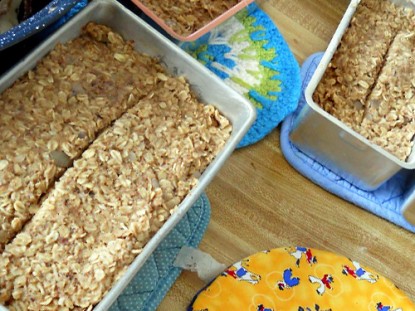
The recipe, as passed from generation to generation: “Take one pork roast, and one beef roast. Cook them with water, salt, onions and bay. Grind the meat, put into a pot with the broth at about a 50:50 ratio and heat. Mix in oatmeal until a wooden spoon stands up straight in the middle of the pot. Cook a little longer then put into loaf pans to cool. Slice then fry and serve on bread or toast.”
I come from German heritage on both sides of my family. Very little of our heritage has been carried over, especially in our food. But my family has one very traditional recipe that everyone enjoys. We have always called it “Greutzwurst“. The recipe has been passed down through the generations, and as with most family recipes, it’s never been written down, and the recipe itself is very vague. My paternal grandmother taught my mother how to make it shortly after she married my dad, and my mom passed it down to me the same way. Part of the traditional “Greutzwurst Story” has always been that “Back in the olden days, they made this recipe by cooking down a pig’s head, but now we just use a pork roast.”
Mom and I have always joked about making Greutzwurst the traditional way, but never got very serious about it. Then one day, while Mom was dropping off some of our yearling cows at the meat processing facility, I jokingly told her she should ask the proprietor how much he would charge us for a pig’s head. The next phone call I received was Mom telling me that we were now the proud owner of a 7 pound pig’s head. I was a bit surprised, and asked how much it cost, to which she replied “Free!” Well, one can’t turn down a free pig’s head, can one??? She took it home and put it in the freezer, and then asked the million dollar question: “Are we actually going to cook this thing?” I was very enthusiastic about the project, and Mom got on board, too. Right up until we figured out that neither one of us knew anything at all about cooking a pig’s head, and none of our older relatives did either.
I figured I’d ask Google about it, since surely someone out there had posted instructions on how to cook a pig’s head. Unfortunately, while many people TALK about cooking a pig’s head, no one has really gone to the trouble of posting a step-by-step tutorial on the process. We found out we were on our own, so we pretty much jumped in with both feet. I’ll walk all of you through the process then go over the end result, and what we would do differently.
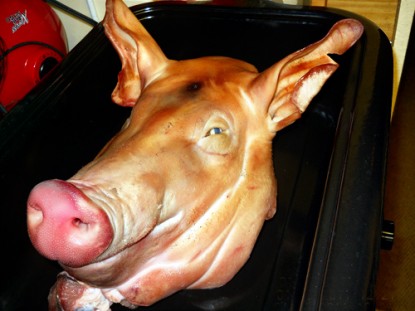
We thawed out the head (we forgot to weigh it, but approximate its weight at 7 lbs), and put it lovingly into our 18-quart Nesco electric roaster. One of the questions we raised was whether or not to leave the skin on, the ears on, the eyeballs in, and the brain in. We decided to just put it in whole, without doing any further butchering.
We added 1 gallon of water, 4 bay leaves, 2 tablespoons of salt, and 3 smallish chopped onions. We also put in a 2 1/2 lb beef rump roast. Put the lid on, turned the temp to 200 degrees, and cooked it overnight, about 8 hrs.
We turned the head over (so the jaw side was now up), turned the roaster up to 300 degrees, and cooked it another 5 hours or so, turning it one more time about halfway through. We also added another 2 cups of water when we turned it the last time.
We then carefully pulled the head and the roast out, set it aside, and strained the liquid into a large pot. We did this to ensure there weren’t any bone pieces or teeth lurking in the broth. After pulling out the bay leaves, we put the onions and other strained leftovers back into the broth and set it all aside. This left us with nothing but Porky, post cooking. The lower jaw had come completely loose, and the meat appeared to be ready to slip off of the skull. We left it in the pan, tented with tin foil, to cool for about an hour.
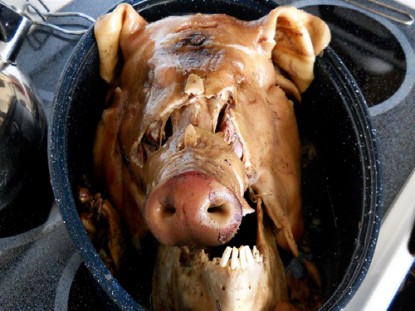

We put the beef roast through the meat grinder then started on the project of tearing apart the head itself. The skin had turned very soft and rubbery and we started by pulling off the ears. We peeled as much meat away from the skin/cartilage as we could before grinding it. Then we moved to the cheeks, the tongue, the snout, and the other bits.
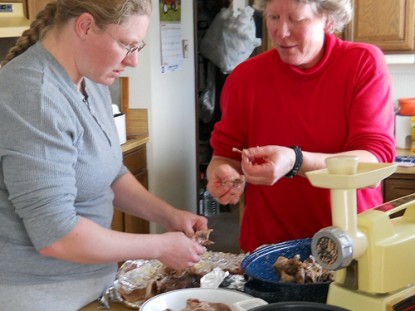
We put pretty much everything through the grinder, with the exception of some pieces of skin that still had bristles on, the ears, the eyeballs (make sure to pull these out when you pull off the cheek meat. I was really surprised how hard they got with cooking!), the upper palate, and the hard cartilage that runs the length of the nasal cavity (yep, we ground up Porky’s snout, tongue, and lips with everything else). Here’s what we were left with.
Click on photo for a larger detail
We ended up doing this next part in thirds, though you could do it all together if you had a big enough (read HUGE) pot.
We put the ground pork, ground beef, and the broth into the pot so that the ratio was pretty close to 50:50, adding water if it seemed too meaty. We just eyeballed it, nothing too exact. We heated it until it was simmering, then started adding in the oatmeal (use old fashioned oats, not quick). Be careful during this stage, because you sort of end up with meat lava that spits everywhere.
Each batch averaged about 8 cups of oatmeal needed to make the spoon stand up straight in the middle. We let it cook a couple more minutes before putting it into various containers to cool.
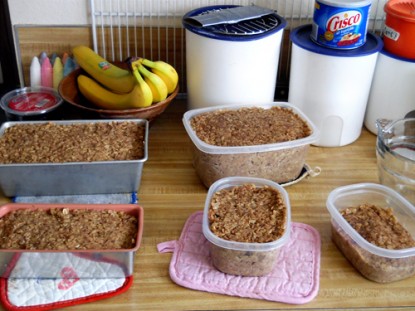
So here’s the Greutzwurst recipe as we did it:
2 1/2 lb beef rump roast (yield: 1 1/4 lbs cooked)
7 lb pig head (yield: 3 3/4 lbs cooked)–if afraid to use a pig’s head, just use a nice pork roast. It will yield differently, though.
2 tablespoons salt
4 bay leaves
3 smallish onions
24 cups old-fashioned oats
about 22 cups water
Total batch yield: 20 lbs Greutzwurst!!
In our family, Greutzwurst is always served sliced, fried in a bit of bacon grease, then on the eater’s choice of toast or bread, lightly smooshed with a fork to break the crust, and sprinkled with salt. The accompanying beverage should always be cold tomato juice.
Get the handy print page and save this to your recipe box here:
Greutzwurst.
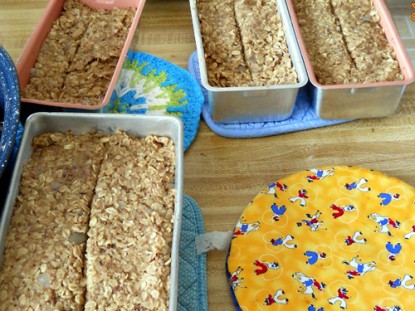
What we learned: We needed more water to cook the head in. We probably could have easily used 1 1/2 gallons, possibly more. We could have cooked it overnight at 250 then flipped the head and finished cooking it the next morning. This Greutzwurst was very dense, and somewhat dry. This is likely because there was a lot more gelatin in the meat than we are used to, and less fat. Next time we would use a fattier beef roast (such as chuck), and possibly also add cubed pork fat (we thought perhaps fresh pork belly (not cured) or something similar would be a good addition, or as a complete substitute for the pig head).
This, like so many peasant dishes, is really about what you like. It’s more of a guideline than a recipe. Add more or less or different spices, use different meat, different grains. Make it into your own special family recipe. Also note that the directions for cooking the pig’s head would work equally well if you were attempting head cheese, or trying it on a different type of head. (Sheep’s head is considered an aphrodisiac in the Middle East.) For anything other than a pig, I would recommend skinning the head first.
Historical Note: In doing my research, I found that true Greutzwurst should actually be ground pork fat mixed with buckwheat, and put into casings. Groetta is the same as the recipe above, except it uses pinhead/steelcut oats. Scrapple is ground pork with added cornmeal. I’m sure there are a dozen other variations, as with any good peasant recipe, it will change by family and by what was available to a particular culture at a particular place.
Do you have a recipe post or kitchen-related story to share on the Farm Bell blog?
Read information here for Farm Bell blog submissions.
Want to subscribe to the Farm Bell blog? Go here.


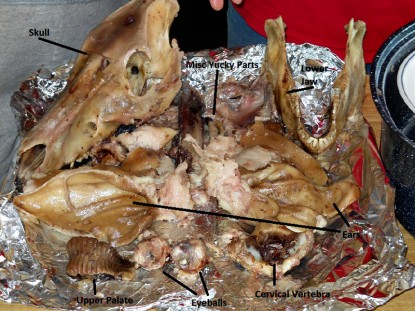

Lierin says:
Your recipe is similar to mine ~ I make scrapple, but NOT with cornmeal. I grew up with a meat market down the road owned by a PA Dutch family that made their own, but they used the buckwheat flour instead of cornmeal. After I moved down south I literally begged them to share their recipe when I was visiting family and they gave it to me.
Like yours, it is rather vague, but I gave it a try and was very pleased with the results (not to mention having scrapple again lol).
It calls for pork roast, good beef stock (not from a can!), salt and pepper to taste, and coriander. The notation said “lots”. Bring to a boil and keep it there while stirring in the buckwheat. Stir constantly until done. Done is when you scoop some up with a wooden spoon, turn it sideways, and it hangs on.
I make mine in my 22 gallon milk pot and generally fill 7 – 8 actual scrapple pans (6 x 6 x 12). To be honest, I’ve never measured how much buckwheat I stir in, but it’s usually around/a bit over the five pound area. I put the roast in and cook it in the stock until it falls apart before I grind it. The directions didn’t say to do that, but it seemed logical so I did.
We eat this the same way you do, sliced/fried. Some of the family liked it with syrup, but I prefer it thin and crispy.
I had to laugh tonight on the last trip out to check my goats (it’s kidding time … got one new one in the barn already!) and I pass by the piggy pen. Mine had that same silly grin on their faces … but with the hair all still attached. Next year I’m naming one Scrapple (this year it was Bacon and Ham). The girl got a reprieve because she’s a very nice girl and I’ve decided to keep her for a breeding sow.
Thanks for sharing this 🙂
On January 19, 2011 at 2:01 am
bonita says:
Ladies, thanks for the time and effort you put into sharing this recipe/adventure. Surprisingly, I didn’t find the pictures at all disturbing, but then my mom made a lot of ‘parts is parts’ dishes. Actually, the pic of Porky in the Pot looks like the inspiration for a drawing on the cover of oh, so many children’s books/nursery rhymes—kinda cute. Oh and the ears…the ears did you give your doggies the ears? Are you going to share the bounty with some older folks? the butcher? (I used to get free parts with the proviso that I bring some of the finished head cheese back to the butchers to share.) Actually, do you live in an area with a large German-ancestry population? Your local paper might be interested in covering your escapade as a human interest or cooking feature esp because you have Porky in the Pot pix. Again, thanks for reminding us that our ancestors used everything their animals had to offer. In the pig’s case, everything but the curl in the tail!
On January 19, 2011 at 2:52 am
judydee says:
I greatly enjoyed this post. Like Bonita, I didn’t mind the Porky pictures at all. But then, I do remember helping my grandmother clean the pig’s head one time. The chitlins though, that’s another story! I would like to try this, but probably will use the pork roast so as to make a much smaller quantity. If you would like to read another account of cleaning the pig’s head, the Foxfire series has a very amusing story about Aunt Arie and how she removed the eyes.
On January 19, 2011 at 6:03 am
Cathy Jones (catray44) says:
This is so cool! I love learning about things I know my ancestors did, but I am clueless about. Thanks for a great and informative post!
On January 19, 2011 at 6:59 am
CindyP says:
Thank you, MrsFuzz and Mom, for documenting as you went along. While I may not actually cook a pig’s head, it was a great read.
And I may have to make some Greutzwurst from a pork roast in a much smaller quantity.
Can you freeze this?
On January 19, 2011 at 7:16 am
brookdale says:
Thanks for posting this interesting recipe.
Many years ago my Grammy would make what she called “hog’s head cheese”. I never saw her actually make it but I remember it in the refrigerator in a loaf pan with waxed paper on top and a brick to hold it down.
I don’t think I ever actually ate any either (I used to be finicky then!) I wonder if it’s the same idea?
On January 19, 2011 at 8:07 am
MrsFuzz says:
Glad you guys liked it! Cindy, it freezes just fine. You can slice it then freeze it, or just freeze it in loaves and thaw it out as you need it.
Brookdale, to my understanding, head cheese is the chopped meat of the head suspended in the gelatin you get from cooking the head down, plus spices. After cooking the head and seeing how much gelatin you end up with, I “get” how that would work pretty well!
Bonita, I so badly wanted to give my dogs the ears, unfortunately, I was at my folks’ house and my dogs were 200 miles away, and I wasn’t gonna carry pigs ears around with me. I was VERY tempted to try to fry them up for sandwiches, but I chickened out. 😀
Lieran, it’s very interesting for me to hear of another person that has a family recipe that they call one thing and everyone else calls something else. That’s one of the things I love about rediscovering old-fashioned cooking. My husband has a cookbook from the late 1880’s, and the recipes are all so vague! “Corned beef: Prepare a side of beef, then put in a barrel with brine.” That’s all the recipe says! What if you don’t know how to prepare a side of beef, or a brine?? *chuckles*
On January 19, 2011 at 8:16 am
LauraP says:
Wonderful! Thank you for sharing the experience, and in such detail! This isn’t something I’ve tried or that I’m really feeling the urge to since I’ve never cared much for this type of meat concoction. (I’d rather use the parts and bits in sausage and soup.) Still, I like knowing how it’s done.
On January 19, 2011 at 9:19 am
lisabetholson says:
I think this is a great post and like the others I didn’t find it too terible.
Bonita, do you have a recipe for Head Cheese? My Grandmother used to make it 50 years ago and I liked hers, but not what is sold in the stores today. I have hogs and will butcher soon, I might like to make some??
If any of you ever butcher hogs, be sure to at least save the jaw meat as there is quite alot there and most people don’t bother they just throw it away.
On January 19, 2011 at 9:23 am
Larissa says:
You had me at “pig’s head”. What a great post!
On January 19, 2011 at 9:51 am
bonita says:
@lisabeth: I must have had a recipe somewhere…I have found 2 recipes so far, but they aren’t the one I used. Since I wasn’t using a whole head, it supplemented the tails and trotters with a veal knuckle to ensure enough geletin. I’ll ferret around some more and let you know what I find. In all it was really quite easy. Boil, Strain, Shred, Mold, Chill.
Oh about the pig jowl, I just read “probably the easiest meat to cure for the home cook. It’s especially important with the jowl to check the meat for glands.”
On January 19, 2011 at 11:19 am
marymac says:
thanks for posting and the pics were great!! This past summer I bought a pig head for 5.00 from a butcher, boy do I know about the work involved ing cooking one. They split the head in half for me, and I took out the brain and eye balls, cooked it in my biggest pot outside on my grill side burner all after noon. I made souse, and it was good, but it made so much that I froze some of it and after freezing I didn’t care for it. I am planning to make scrapple maybe today. I have a few cans of government pork and it works out great for making scrapple!! Thanks for this post it was fun!!
On January 19, 2011 at 1:12 pm
Astrid says:
Great story, didn’t mind the pictures, but then I butcher myself.
Never done anything with the head (except trow it in the field for the coyotes)
Think I should save a head next butchering day.
Thanks for sharing, really enjoyed it.
On January 19, 2011 at 3:26 pm
angela p says:
I remember my grandparents making this or something similar. They called it head cheese.My Grandpa was from the Netherlands near the German border. I was never a fan of it, just couldnt get use to the texture, sorry. Growing up on a farm was an experience to say the least. My mom who is also German made stuff with cows tongue. You just never knew what was for dinner until you took the lid off the pot! I think its a good thing that they used all or nearly all of the animals they raised, nothing seemed to go to waste. Wonderful documentary here, very interesting!
On January 19, 2011 at 4:49 pm
BethieofVA says:
Great post!! What a great read.
On January 19, 2011 at 4:57 pm
NorthCountryGirl says:
Mrs.Fuzz, what a great post. My father was PA Dutch and he would make scrapple, liverwurst, and such. My favorite was scrapple. Fried with a dollop of jelly on it. The salty/sweet dish was a treat for breakfast. He was born during the depression and he said the farmers used everything but the squeal! Thanks for the pictures. It was interesting to see how these things were done.
On January 19, 2011 at 5:56 pm
Patrice says:
I didn’t allow any of our pigs near the computer today!
On January 19, 2011 at 5:58 pm
bonita says:
I’ve been looking for my old head cheese recipe. For the record, head cheese is just molded meat and animal gelatin–carrots, hard boiled egg added for interest. And for the multilingual among us: souse Middle English, from Anglo-French suz, souce pickling juice; sülze, German; koseliena, Lithuanian, and Pihtije, Serbian. I know, I know, some of us are just hopeless!
On January 19, 2011 at 6:30 pm
Urbanite says:
Thank you for sharing the information and pictures. Like some others, I expected the pictures to be more gross than they really were. The second pig head picture is kind of icky, but nothing I couldn’t look at. In fact I found the process to be quite interesting, although I would have to be facing imminent death from starvation before I personally would cook a pig’s head. Buying packaged meat makes it easy to gloss over where that meat really came from. Hypocritical? You bet! And completely unashamed about it, too, LOL.
I was surprised the brain wasn’t removed. But in thinking about it, brain is edible and it probably is easier to just cook it rather than remove it raw.
On January 19, 2011 at 10:05 pm
MrsFuzz says:
Originally, we asked the butcher if he could cut the head in half to make for easier cooking, but he told us that the teeth break his bandsaw, so he couldn’t. Other than the labor involved in sawing the head in half ourselves, we didn’t want to have to worry about a bunch of bone splinters, etc. We didn’t think to open up the skull and see how much brain was left after cooking, but I imagine most of it was still in there. When I was little and we butchered calves, our gourmet breakfast meal was brains and eggs, so I don’t really have a problem with the brains. Tastes like liver, but is a lot more tender. 🙂
On January 19, 2011 at 10:28 pm
Ross says:
I wonder why in general we have an aversion to cooking animals or fish with the heads still attached? As this thread demonstrates there is a considerable amount of good meat to be found between the nose and the neck.
On January 19, 2011 at 11:34 pm
bonita says:
Found 7 head cheese recipes, 3 are old Chicago Tribune recipes which means they’re ones my mother clipped and saved over 50 years ago. They’re all pretty much the same. After looking closely at the selection, I spied water/grease spots on one. That was the one! It all came back to me. I’ve posted my recipe for head cheese over at FBR.
On January 23, 2011 at 12:35 pm